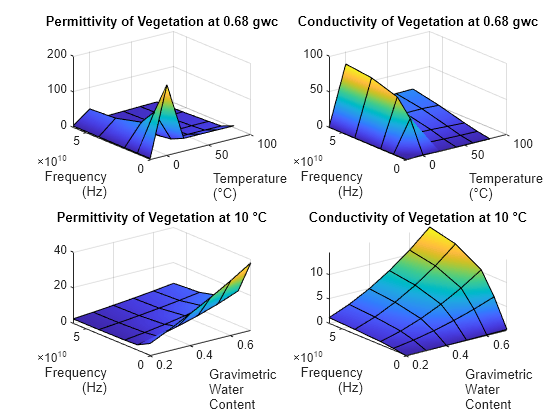earthSurfacePermittivity
Permittivity and conductivity of earth surface materials
Syntax
Description
The earthSurfacePermittivity function computes the real relative
permittivity, conductivity, and complex relative permittivity of earth surface materials. The
computations are based on the methods and equations presented in International
Telecommunication Union Recommendation (ITU-R) P.527-5 through ITU-R P.527-6 [1]. The
earthSurfacePermittivity function provides various syntaxes to account for
characteristics germane to the specified surface material.
Water
[
calculates the real relative permittivity, conductivity, and complex relative permittivity
of pure water at the specified frequency and temperature.epsilon,sigma,complexepsilon] = earthSurfacePermittivity("pure-water",fc,temp)
Ice
[
calculates the real relative permittivity, conductivity, and complex relative permittivity
of pure ice at the specified frequency and temperature.epsilon,sigma,complexepsilon] = earthSurfacePermittivity("pure-ice",fc,temp)
[
calculates the real relative permittivity, conductivity, and complex relative permittivity
of wet ice at the specified frequency and liquid water volume fraction.epsilon,sigma,complexepsilon] = earthSurfacePermittivity("wet-ice",fc,liqfrac)
Snow
Soil
[
calculates the real relative permittivity, conductivity, and complex relative permittivity
of soil at the specified frequency, temperature, percentage of sand by volume, percentage
of clay by volume, specific gravity, and volumetric water content. This syntax uses an
approximation formula for the bulk density of the soil. epsilon,sigma,complexepsilon] = earthSurfacePermittivity("soil",fc,temp,sandpercent,claypercent,sg,vwc)
[
specifies the bulk density of the soil in addition to the input arguments from the
previous syntax.epsilon,sigma,complexepsilon] = earthSurfacePermittivity("soil",fc,temp,sandpercent,claypercent,sg,vwc,bulkdensity)
Examples
Input Arguments
Output Arguments
More About
References
[1] International Telecommunications Union Radiocommunication Sector. Electrical Characteristics of the Surface of the Earth. Recommendation P.527. ITU-R, approved September 27, 2021. https://www.itu.int/rec/R-REC-P.527/en.
[2] Mohr, Peter J., Eite Tiesinga, David B. Newell, and Barry N. Taylor. “Codata Internationally Recommended 2022 Values of the Fundamental Physical Constants.” NIST, May 8, 2024. https://www.nist.gov/publications/codata-internationally-recommended-2022-values-fundamental-physical-constants.

